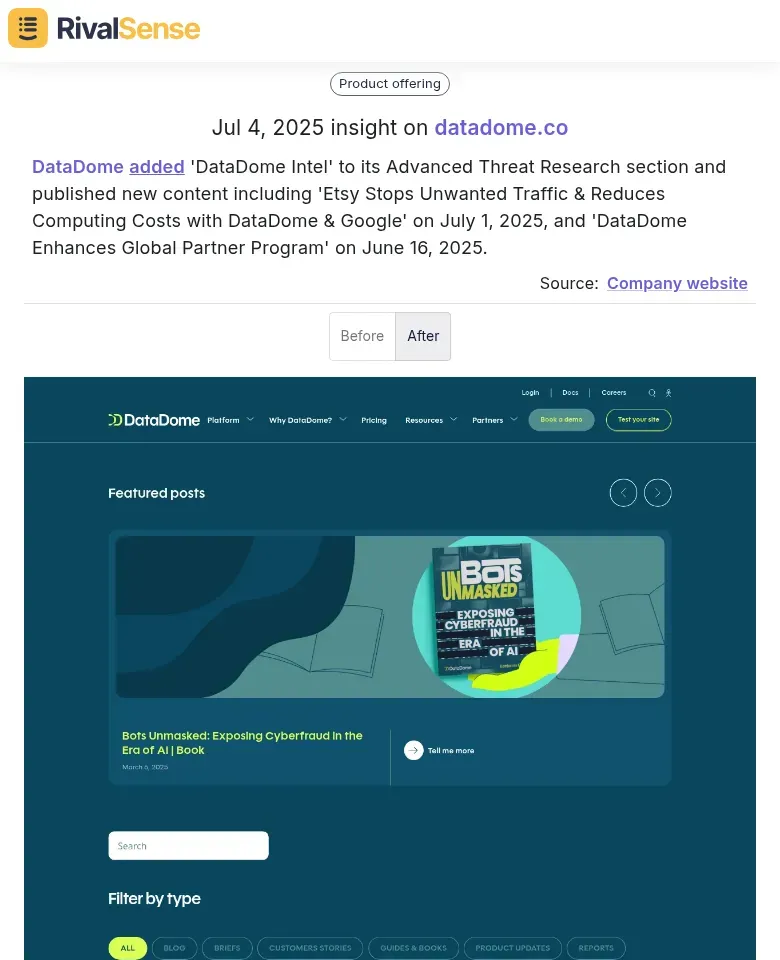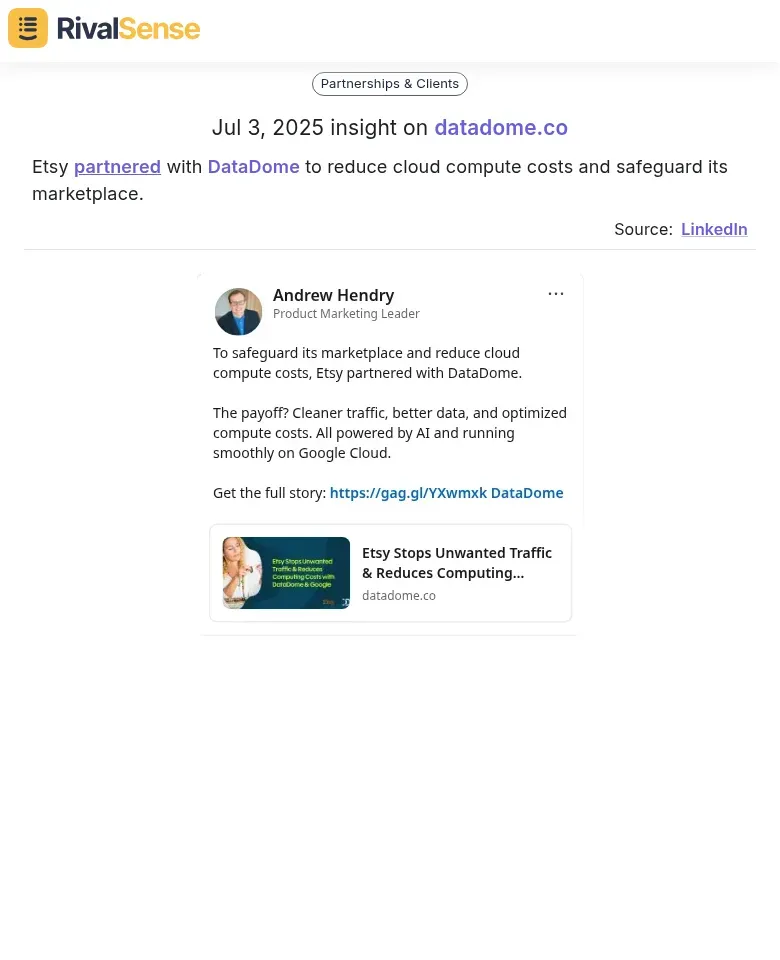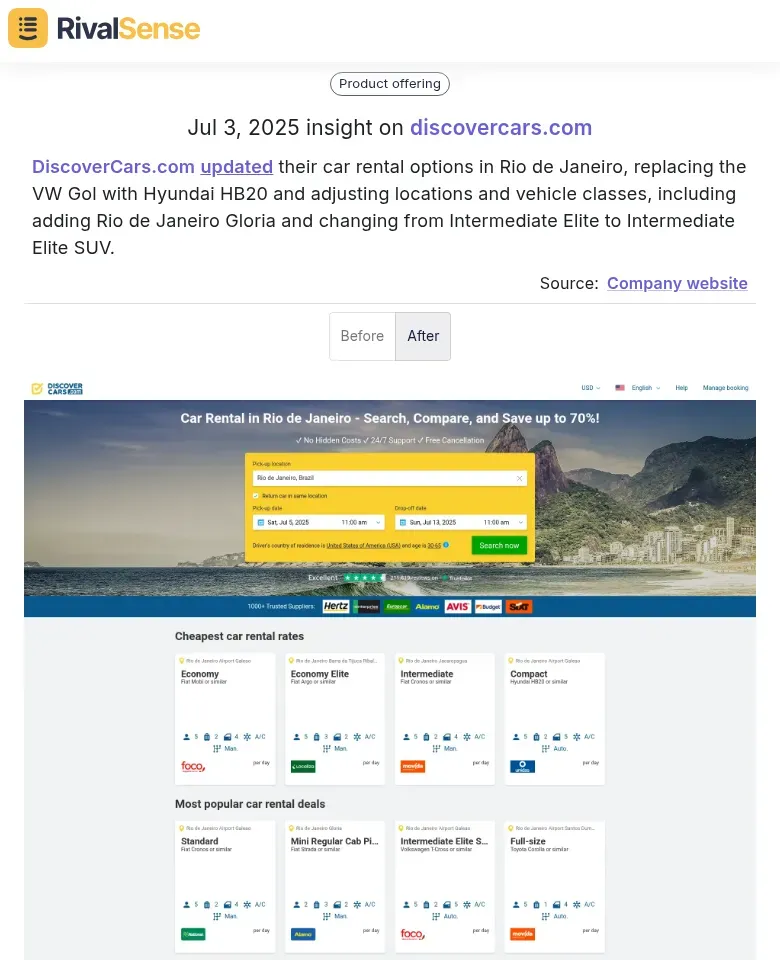How to Conduct Competitor Analysis for B2B Companies: A Step-by-Step Guide
Competitor analysis is essential for strategic planning in B2B markets. Understanding rivals' strengths, weaknesses, and tactics helps differentiate your brand and seize opportunities. This practical guide delivers actionable steps to conduct effective competitor analysis.
Step 1: Identify Your Competitors
Begin by mapping your competitive landscape across direct and indirect players. Direct competitors target similar audiences with comparable solutions, while indirect ones solve the same problems differently. Tools like RivalSense automate this discovery by scanning 80+ sources including websites, registries, and social media.
Step 2: Analyze Competitor Products and Services
Evaluate features, pricing, and service gaps in competitors' offerings. Tracking product updates reveals strategic shifts—like when DataDome added 'DataDome Intel' to its Advanced Threat Research section alongside new content pieces. Such insights help anticipate market trends and refine your positioning.

Monitoring product enhancements (like DataDome's) reveals innovation priorities
Step 3: Assess Competitor Marketing Strategies
Examine content themes, SEO tactics, social engagement, and ad campaigns. Notice their messaging angles and value propositions. Are they emphasizing benefits you've overlooked? Regularly review their content upgrades for hidden opportunities.
Step 4: Monitor Competitor Customer Feedback
Analyze reviews, testimonials, and case studies to uncover pain points customers experience with rivals. This feedback directly informs your product development and service improvements.
Step 5: Track Competitor Partnerships and Events
Strategic alliances signal growth ambitions. When Etsy partnered with DataDome to reduce cloud costs, it highlighted shared objectives around efficiency and security. Monitoring such collaborations exposes expansion strategies.

Partnership insights (like Etsy's) reveal market expansion tactics
Step 6: Evaluate Competitor Financial Health
Review funding announcements or financial reports when available. These indicate growth capacity and R&D investment levels, helping you anticipate their market moves.
Step 7: Benchmark Your Performance
Compare metrics like market share, customer satisfaction, and brand awareness against competitors. Use reliable data sources to ensure accurate comparisons.
Step 8: Identify Opportunities and Threats
Synthesize findings into clear differentiators and vulnerabilities. Focus on actionable gaps where your solution can outperform rivals.
Real-World Insight Examples
Concrete competitor moves offer strategic lessons:
- Service Adjustments: When DiscoverCars.com updated Rio de Janeiro rentals (replacing vehicles and adjusting classes), it demonstrated local market adaptation. Tracking such changes helps refine your regional offerings.

Service updates (like DiscoverCars') signal market responsiveness
Practical Tips for Effective Analysis
- ✅ Automate Monitoring: Use tools like RivalSense for real-time alerts on competitor moves
- ✅ Prioritize Actionable Intel: Focus on insights driving product, pricing, or marketing decisions
- ✅ Review Quarterly: Revisit your analysis every 3 months to capture market shifts
Why RivalSense Streamlines Competitor Tracking
- 🔍 Comprehensive Coverage: Tracks product launches, pricing changes, events, partnerships, and regulatory updates
- 📊 Decision-Grade Data: Insights sourced from executives and verified channels—not survey panels
- ✉️ Weekly Digests: Condensed email reports save hours of manual research
Final Thoughts
Competitor analysis is an ongoing process, not a one-time task. Systematic monitoring uncovers opportunities to differentiate and outmaneuver rivals. Modern tools transform overwhelming data into actionable intelligence.
Ready to upgrade your competitive strategy? Try RivalSense free at https://rivalsense.co/ and get your first competitor report today!
📚 Read more
👉 AI & Automation: Competitive Intelligence for Growth
👉 How PandaDoc's Revenue Ops Shift Can Transform Your Competitive Strategy
👉 Facebook Insights: Real-World Competitive Intelligence for B2B Leaders
👉 AI-Powered Insights: Transforming HR & Finance Competitor Analysis
👉 Decoding Market Entry: How Digital Rivals Are Transforming Strategies
